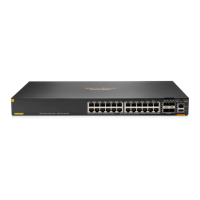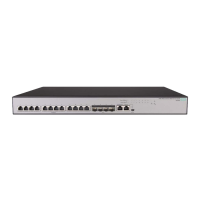245
ipv6 neighbor
Use ipv6 neighbor to configure a static neighbor entry.
Use undo ipv6 neighbor to delete a static neighbor entry.
Syntax
ipv6 neighbor ipv6-address mac-address { vlan-id port-type port-number | interface interface-type
interface-number } [ vpn-instance vpn-instance-name ]
undo ipv6 neighbor ipv6-address interface-type interface-number
Default
No static neighbor entries exist.
Views
System view
Predefined user roles
network-admin
Parameters
ipv6-address: Specifies the IPv6 address of the static neighbor entry.
mac-address: Specifies the MAC address (48 bits) of the static neighbor entry, in the format of
H-H-H.
vlan-id: Specifies the VLAN ID of the static neighbor entry, in the range of 1 to 4094.
port-type port-number: Specifies a Layer 2 port of the static neighbor entry by its type and number.
interface interface-type interface-number: Specifies a Layer 3 interface of the static neighbor entry
by its type and number.
vpn-instance vpn-instance-name: Specifies an MPLS L3VPN instance to which the static neighbor
entry belongs. The vpn-instance-name argument represents the VPN instance name, a
case-sensitive string of 1 to 31 characters. If you do not specify a VPN instance, this command
configures a static neighbor entry for the public network.
Usage guidelines
A neighbor entry stores information about a link-local node. The entry can be created dynamically
through NS and NA messages, or configured statically.
The device uniquely identifies a static neighbor entry by the neighbor's IPv6 address and the local
Layer 3 interface number. You can configure a static neighbor entry by using either of the following
methods:
• Method 1—Associate a neighbor IPv6 address and link-layer address with the Layer 3
interface of the local node.
• Method 2—Associate a neighbor IPv6 address and link-layer address with a Layer 2 port in a
VLAN containing the local node.
You can use either of the previous configuration methods to configure a static neighbor entry for a
VLAN interface.
• If Method 1 is used, the neighbor entry is in INCMP state. After the device obtains the
corresponding Layer 2 port information, the neighbor entry goes into REACH state.
• If Method 2 is used, the port specified by port-type port-number must belong to the VLAN
specified by vlan-id and the corresponding VLAN interface must already exist. After the static
neighbor entry is configured, the device associates the VLAN interface with the IPv6 address to
uniquely identify the static neighbor entry. The entry will be in REACH state.

